Fan art is amazing - and don't let anybody tell you otherwise (and boy, will they ever try)! We can rhapsodize about our favorite things all day long (and boy, do we ever try!), but eventually we run out of ways of expressing the depth of our emotion when it comes to a series.
Along came fan art. Presumably, people are fans of something other than books, and therefore create fan art for things utterly unrelated to books - but this is a bookish blog, and a bookish community, and here all the fan art discussion is of the bookish variety. Also, not to be self-aggrandizing, but bookish fandoms lend themselves best to all forms of artistic expression, precisely because they take place entirely inside our heads. A character can look however we want them to look - and the same holds true for a place or a bizzarre scene.
Bizarre scenes might be the best. It's still up for debate. But bookish fan art is our favorite. There is no debate to be had here.
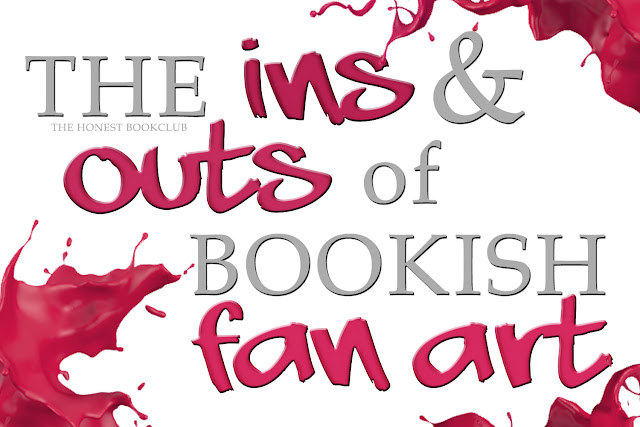
When I published my last piece and emerged from my blanket fort (wherein I hide upon publication of any piece - it's hard to declare something complete when you're an indecisive pumpkin), I got quite a lot of fan-art-specific questions, which all boiled down to the same thing. And in the interest of covering all my bases - behold! An exhaustive and exhausting fan art post to answer any and all queries, questions, musings, zen koans and limericks I've gotten on the subject.

What is this fan art of which you speak?
You create art in the medium of your choice based on an already existing book. It's as simple (and as complicated) as that. And usually it errs on the side of complicated for me. But I'm 50% caffeine, 50% anxiety, so I'm by no means representative of all bookish fan artists.
... Or maybe I am.
So I create Photoshop art based on books?
This is what I do. You, however, may sing it, play it, traditionally paint it, make up an interpretive dance routine to it, write fanfiction for it, or express the degree to which the piece inspired you in any way your glorious heart desires.
For alternative ideas, I shall now point you to this Throne of Glass scene in short-film form, these bookish cookery shenanigans, and to Maggie Stiefvater, who composes and records her own soundtracks for her own books, and then creates visual art for them, because she is the queen of everything and we are lowly minions destined to flail helplessly in her presence.
I'm not talented at anything at all, but I want to create fan art!
You'll be happy to know that this is the question/statement I get asked/told the most. Hourly, in conversations with my friends. Daily, in conversations with my co-blogger. Weekly, in assorted social media messages. And recently (and memorably) in a Tumblr comment thread.
In my experience, this is never the case. Statistically speaking, chances are overwhelming that you have an affinity for at least one of the many, many aforementioned art forms I listed above. And if you've truly never drawn, painted, animated, photographed, written, cooked, played music, filmed something, danced, sung or acted - then good news galore! There's a vast field of art yet available for you to explore, and discover which of said many forms you are good yet - and then turn it into an ode to other artists and fandoms.
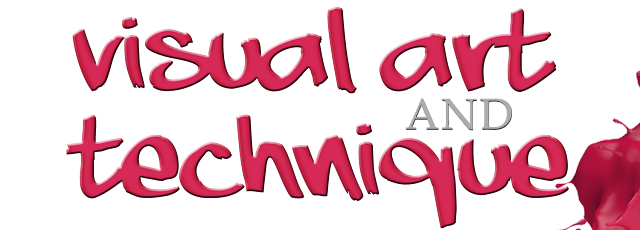
What can I do in terms of visual art?
There are more fan art forms on heaven and earth, Horatio, than are dreamt of in your philosophy. In terms of visual art, I'd divide it thusly:

My (intermediate) knowledge extends only as far as digital art. The rest, as witnessed by the images above, I'm still working on. My longstanding home-away-from-home, however, has excellent examples of each and every single one of these (sub)categories, tons of input, and inspiration galore.
Where can I find tutorials and additional information?
EVERYWHERE. The internet is a Mecca for all things visual and artsy. I'd recommend deviantArt first - a community centered only and specifically on art (of almost any kind). Then there's Pinterest, which also features both art and links to art tutorials. But also Tumblr. WeHeartIt. Instagram. Art blogs. Online merchandise stores like Etsy, RedBubble and Society6. Your school bulletin board. The back of your closet. That coffee shop 'round the corner. ART IS EVERYWHERE.
But suffice it to say - Google knows. And if you go off of an assumption that there is an answer for whatever you may need, you'll rarely be disappointed. If you find yourself disappointed, however - I'm right here to answer the questions that stump Google. (#wise)
But suffice it to say - Google knows. And if you go off of an assumption that there is an answer for whatever you may need, you'll rarely be disappointed. If you find yourself disappointed, however - I'm right here to answer the questions that stump Google. (#wise)
I am an indecisive pumpkin. Where should I start?
If you're completely new to digital art and to graphic design software, I'd strongly suggest starting with some trial-and-error unofficial sketches, some tutorials, a class, or photomanipulation - the latter being that thing which sounds like photography post-production that is actually nothing like photography post-production. (Photomanipulation, in essence, allows you to take stock images available online, edit them, paint over them, cut out whichever portions you need, and import them into other (stock) images. It's basically digital collage, with painting. And it can lend some truly impressive results.)
If you're already familiar with the ins and outs of your graphic software of choice and you're confident enough in your drawing/painting skill (or really good at faking it #TeamMe), then you can go ahead and transition to plain, old digital painting: an empty canvas before you, a mouse/pen in your hand, and nothing but the limits of your imagination
What does your process look like? How long until your piece is done?
When I first started my current WIP, dinosaurs still roamed the earth. I am slow, my friends. I am the ultimate tortoise of the digital art community. But this is chiefly because (a) I am terrible at time management at times, and (b) in 2009 when I first got started it didn't occur to me to use tutorials at all. So I'm entirely self-taught, and therefore 4.758 times slower than a professional artist. Heed my advice, oh wise ones: put the Tutorial section of deviantArt to a good use.
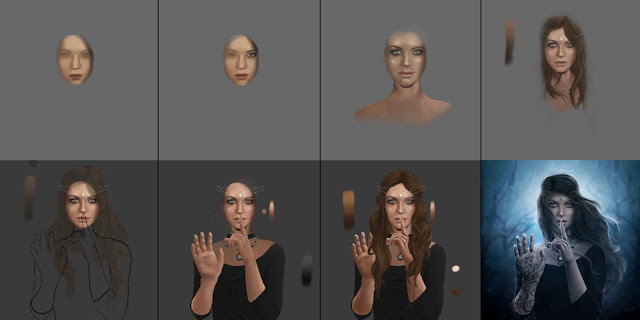
Otherwise, my process is this: chaotic, disorganized, often indecisive, all-consuming, time-consuming, manic, stressful, but thoroughly and utterly enjoyable the entire time.

Otherwise, my process is this: chaotic, disorganized, often indecisive, all-consuming, time-consuming, manic, stressful, but thoroughly and utterly enjoyable the entire time.
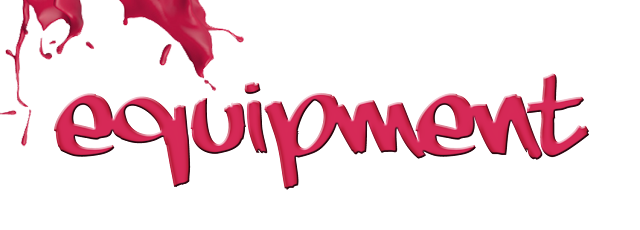
Not unless you're reading this on your phone (in which case... I appreciate that diligence). To create digital art, all you really need is the following:
○ a working computer
○ a mouse or a graphics tablet
○ graphic software of your choice.
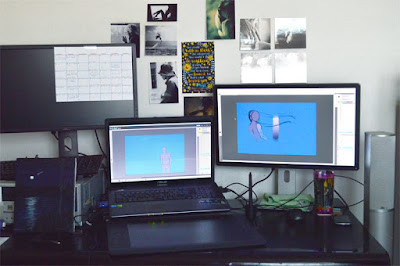
The computer and the mouse, presumably, you have covered. While the mouse does make it more challenging to create art, as opposed to a graphics tablet, it doesn't make it impossible. I started creating digital art in 2009 and didn't get a graphics tablet until 2013. If you're dabbling in photo manipulation, a mouse is plenty.
If you have your heart set on a graphics tablet for painting, however, more good news (I am your regular singing telegram today) - they aren't as expensive as you're thinking. By all means - do your research before purchasing! But depending on the model, the size, and the brand - they can come as cheap as $50. Originally, as a student on a budget, I'd had my heart set on Wacom's Bamboo model, which now has sequels/offspring in the form of Wacom One series, or the Wacom Intuos Art/Comic/Draw/Photo models. Alternatively, the Huios lower-range series is also both affordable and has really good reviews and customer feedback. I'd look into the Ugee brand, too, and compare.
Pro tips: (1) The size of the tablet isn't the same as the size of its active area. Mind the distinction. (2) The amount of pressure points is more important than whether they're wireless or glossy or shiny or whatever else the company advertises as the tablet's key features. (3) Pens are necessary; pens with erasers are handy.
It's the software, ironically, that tends to be the priciest. But if you're venturing here from any sort of blogging community (your own blog, Tumblr, etc.), chances are you already own some sort of graphic software, and can navigate your way around one. If not - you still have cost-effective options. While the favored Adobe suite is pricey, there's a myriad of Photoshop-reminiscent software at a fraction of the cost. Some even come free. Also, if you're a student or employed in an IT company, I'd recommend checking to see if there isn't software available to you through your school/company, on their community license. My University offers free Adobe student license to its students enrolled in graphics/IT/art/design programs. Some graphics tablets also come with free software.
○ a working computer
○ a mouse or a graphics tablet
○ graphic software of your choice.

Don't panic - that picture is deceiving. That picture is what happens when a brother (mine) moves to NYC for the summer and a sister (me) usurps his super decked-out workspace.
The computer and the mouse, presumably, you have covered. While the mouse does make it more challenging to create art, as opposed to a graphics tablet, it doesn't make it impossible. I started creating digital art in 2009 and didn't get a graphics tablet until 2013. If you're dabbling in photo manipulation, a mouse is plenty.
Created with a mouse. I'm tempted to attack it with a tablet now, of course, but as it stands, it is an argument in a mouse's favor.
If you have your heart set on a graphics tablet for painting, however, more good news (I am your regular singing telegram today) - they aren't as expensive as you're thinking. By all means - do your research before purchasing! But depending on the model, the size, and the brand - they can come as cheap as $50. Originally, as a student on a budget, I'd had my heart set on Wacom's Bamboo model, which now has sequels/offspring in the form of Wacom One series, or the Wacom Intuos Art/Comic/Draw/Photo models. Alternatively, the Huios lower-range series is also both affordable and has really good reviews and customer feedback. I'd look into the Ugee brand, too, and compare.
Pro tips: (1) The size of the tablet isn't the same as the size of its active area. Mind the distinction. (2) The amount of pressure points is more important than whether they're wireless or glossy or shiny or whatever else the company advertises as the tablet's key features. (3) Pens are necessary; pens with erasers are handy.
It's the software, ironically, that tends to be the priciest. But if you're venturing here from any sort of blogging community (your own blog, Tumblr, etc.), chances are you already own some sort of graphic software, and can navigate your way around one. If not - you still have cost-effective options. While the favored Adobe suite is pricey, there's a myriad of Photoshop-reminiscent software at a fraction of the cost. Some even come free. Also, if you're a student or employed in an IT company, I'd recommend checking to see if there isn't software available to you through your school/company, on their community license. My University offers free Adobe student license to its students enrolled in graphics/IT/art/design programs. Some graphics tablets also come with free software.
Disclaimer: do as I say, kids, not as I do. By no means am I saying you need the same equipment I need to achieve equal or better results. I do, however, luuuurve my equipment. (So much so that everything is named Monty. It's a sign of love in Lexieville.)
I own an 18.4" ASUS laptop. Its name is Monty Jr. I am a Windows-based human and a mobile human, but I needed good graphics and visibility. Ergo - giant laptop. I also use an external cooler pad (attachable via USB port) that I make sure to place my laptop on whenever I'm Photoshopping. My pieces tend to run large, both in pixel size and MB/GB size, and when I run multiple at once, it's tasking on a computer. So I feed it more cool air to keep it happy.
As far as graphic equipment, I work on a Wacom Intuos Pro Touch L tablet, and we've very, very best friends. Her name is Jessamine. I also hang out with Monty - my Nikon D3200 dSLR for photography. And I pair it all up with my 'base of operations' - Adobe Photoshop CC (for actual painting) and Adobe Illustrator CC (for line art and vector graphics).

Where do I post my artwork when I'm done?
Can I sell my fan art? Is that legal?
It depends on your medium of choice. If you used anyone else's images to create your own (as is the case with photomanipulation and/or mixed media), you would need to look into every stock artist's individual rules and potentially ask them for permission. Some are happy to see their stock help others do well, others will ask for a cut of the profits. With digital painting, on the other hand, your work is entirely your own, but...
Pro tip of the day: ask the author. Find the author whose work you're honoring with your art, either on social media or via email, and ask if they would be okay with it. As with stock artists, some authors are happy to greenlight this, and some will want to work out a commercial license with you so they get a percentage of your sales profits.
Where can I sell it?
I own an 18.4" ASUS laptop. Its name is Monty Jr. I am a Windows-based human and a mobile human, but I needed good graphics and visibility. Ergo - giant laptop. I also use an external cooler pad (attachable via USB port) that I make sure to place my laptop on whenever I'm Photoshopping. My pieces tend to run large, both in pixel size and MB/GB size, and when I run multiple at once, it's tasking on a computer. So I feed it more cool air to keep it happy.
As far as graphic equipment, I work on a Wacom Intuos Pro Touch L tablet, and we've very, very best friends. Her name is Jessamine. I also hang out with Monty - my Nikon D3200 dSLR for photography. And I pair it all up with my 'base of operations' - Adobe Photoshop CC (for actual painting) and Adobe Illustrator CC (for line art and vector graphics).

Where do I post my artwork when I'm done?
In my not-at-all biased opinion, there's no such thing as a bad place for fan art. You may post it anywhere. (Though maybe don't email it to government offices and the like.) The places where your art is sure to get the most visibility, however, is Tumblr, deviantArt, your own personal blog, Pinterest, or wherever you already have an established base of friends/followers.
Don't forget to also post it on your personal social media, and by all means - notify the author of the original work. There are few things as dear to an author as seeing how their work inspired and impacted others. And what with books being a uniquely intrinsic experience, it's incredibly thought-provoking (and mindblowing) to get to see how someone envisaged a character/scene/concept in their mind.
Can I sell my fan art? Is that legal?
It depends on your medium of choice. If you used anyone else's images to create your own (as is the case with photomanipulation and/or mixed media), you would need to look into every stock artist's individual rules and potentially ask them for permission. Some are happy to see their stock help others do well, others will ask for a cut of the profits. With digital painting, on the other hand, your work is entirely your own, but...
Where can I sell it?
Art-based websites like deviantArt offer print sales right off the website. Likewise, online merchandise stores like RedBubble, Society6, Zazzle, etc. make it possible for you to upload your artwork, and they do the job of printing it, packaging it, and shipping it to customers - for a cut of the profits. (Sensing a theme yet?) You may also choose to print and ship the artwork yourself, either via proxies like Etsy, e-commerce websites like Ebay, or via your own website. And then there's the possibility of opening an actual, physical, real-life shop in your area.
May I friend you on your artsy social media?
Not only may you - I insist upon it! (I also routinely hand out virtual cookies, so you don't want to miss it, really.) I am:
My online stores with graphic design / typography type bookish merch are at:






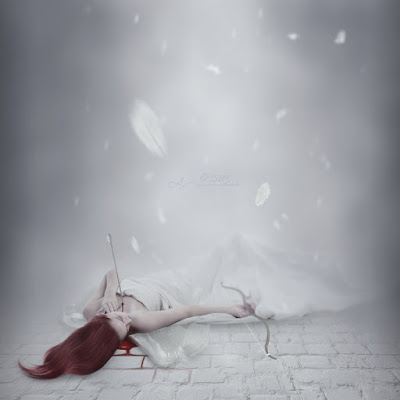















)sm.jpg)





1 Comments
MapleStory.es - 3D isometric adventure MMORPG<
ReplyDeleteDownload MapleStory and start the game.
https://maplestory.es/
MapleStory is a free to download 2D online video game of the MMORPG genre, created by the Korean company Wizet. Although the game is free to play, it includes other items that can be purchased for real money. Around the world, the game has millions of users. The story of the game is about some travelers who seek to save the Maple World from the terrible Black Mage. In this plot, the travelers become stronger as they eliminate the enemies of the game, many creatures of different appearance. As they advance in level, travelers choose the paths and disciplines to follow, which we will detail below.
What is MapleStory?
MapleStory 2 is a 3D isometric adventure MMORPG in which players create their own character and select one of several jobs to explore the new Maple World. Players will find several NPCs with various Quests, Monsters, and Bosses from the previous version, as well as completely new ones to fight against. The game also features dungeons and raids for players to team up with each other to complete.
Out of action
There are also a variety of activities for players to participate in, such as buying and building personal homes, crafting with Life Skills, fishing, composing music, creating custom user content such as custom clothing, and much more.
History of the last UPDATE
Nexon published the first closed beta test of the global version which ran from May 9, 2018 to May 16, 2018, and a second closed beta ran from July 18 to August 1, 2018. The game launched on October 10, 2018 with players who purchased a Founder's Pack on or after October 1, 2018. On Wednesday, May 27, 2020, Nexon ended service for the global version of MapleStory 2.
https://maplestory.es/
Post a Comment